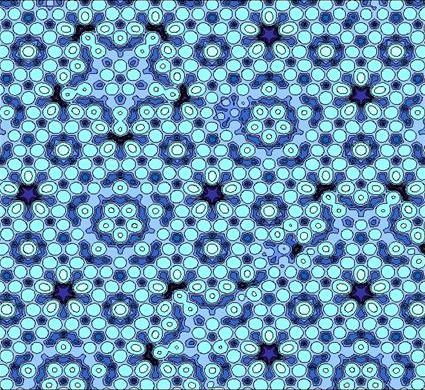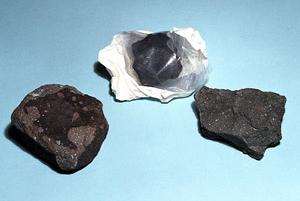|
Icosahedrite
Icosahedrite is the first known naturally occurring quasicrystal phase. It has the composition Al63Cu24Fe13 and is a mineral approved by the International Mineralogical Association in 2010. Its discovery followed a 10-year-long systematic search by an international team of scientists led by Luca Bindi and Paul J. Steinhardt to find the first natural quasicrystal. It occurs as tiny grains in a small sample labelled " khatyrkite" (catalog number 46407/G, housed in The Museum of Natural History, University of Florence, Italy), collected from an outcrop of weathered serpentinite in the Khatyrka ultramafic zone of the Koryak-Kamchatka area, Koryak Mountains, Russia. The rock sample also contains spinel, diopside, forsterite, nepheline, sodalite, corundum, stishovite, khatyrkite, cupalite and an unnamed AlCuFe alloy. Evidence shows that the sample is actually extraterrestrial in origin, delivered to the Earth by a CV3 carbonaceous chondrite asteroid that dates back 4.5 Gya. A geolog ... [...More Info...] [...Related Items...] OR: [Wikipedia] [Google] [Baidu] |
Quasicrystal
A quasiperiodic crystal, or quasicrystal, is a structure that is ordered but not periodic. A quasicrystalline pattern can continuously fill all available space, but it lacks translational symmetry. While crystals, according to the classical crystallographic restriction theorem, can possess only two-, three-, four-, and six-fold rotational symmetries, the Bragg diffraction pattern of quasicrystals shows sharp peaks with other symmetry orders—for instance, five-fold. Aperiodic tilings were discovered by mathematicians in the early 1960s, and, some twenty years later, they were found to apply to the study of natural quasicrystals. The discovery of these aperiodic forms in nature has produced a paradigm shift in the field of crystallography. In crystallography the quasicrystals were predicted in 1981 by a five-fold symmetry study of Alan Lindsay Mackay,—that also brought in 1982, with the crystallographic Fourier transform of a Penrose tiling,Alan L. Mackay, "Crystall ... [...More Info...] [...Related Items...] OR: [Wikipedia] [Google] [Baidu] |
Khatyrkite
Khatyrkite ( ) is a rare mineral which is mostly composed of copper and aluminium, but may contain up to about 15% of zinc or iron. Its chemical structure is described by an approximate formula or . It was discovered in 1985 in a placer in association with another rare mineral cupalite (). These two minerals have only been found at in the area of the Iomrautvaam, a tributary of the Khatyrka river, in the Koryak Mountains, in Anadyrsky District (former Beringovsky District), Chukotka, Russia. Analysis of one of the samples containing khatyrkite showed that the small rock was from a meteorite. A geological expedition has identified the exact place of the original discovery and found more specimens of the Khatyrka meteorite. The mineral's name derives from the Khatyrka (russian: Хатырка) zone where it was discovered. Its type specimen (defining sample) is preserved in the Mining Museum in Saint Petersburg, and parts of it can be found in other museums, such as Museo di S ... [...More Info...] [...Related Items...] OR: [Wikipedia] [Google] [Baidu] |
Luca Bindi
Luca Bindi (born 1971) is an Italian geologist. He holds the Chair of Mineralogy and Crystallography and is the Head of the Department of Earth Sciences of the University of Florence. He is also a research associate at the Istituto di Geoscienze e Georisorse of the National Research Council (Italy) (CNR). He has received national and international scientific awards that include the President of the Republic Prize 2015 in the category of Physical, Mathematical and Natural Sciences. Since 2019 is a Member of the National Academy of Lincei. Bindi is credited with the co-discovery of the first known natural quasicrystal, having identified a potential candidate from the mineral collection at the "Università di Firenze". The discovery ultimately showed that quasicrystals can form spontaneously in nature and remain stable for geological times. Recognition Awards for his research, include: * Panichi Prize for mineralogical investigations of the Italian Society of Mineralogy and Petro ... [...More Info...] [...Related Items...] OR: [Wikipedia] [Google] [Baidu] |
Cupalite
Cupalite is a rare mineral which is mostly composed of copper and aluminium, but might contain up to several percent of zinc or iron; its chemical structure is therefore described by an approximate formula or . It was discovered in 1985 in placers derived from serpentine, in association with another rare mineral khatyrkite (CuAl2). Both minerals are thus far restricted to the area of the Iomrautvaam, in the Khatyrka ultramafic (silicon-poor) zone of the Koryak–Kamchatka fold area, Koryak Mountains, Anadyrsky District, Chukotka Autonomous Okrug, Far Eastern Federal District, Russia.Razin, L.V., N.S. Rudashevskii, and L.N. Vyal'sov. (1985) New natural intermetallic compounds of aluminum, copper and zinc – khatyrkite CuAI2, cupalite CuAI and zinc aluminides – from hyperbasites of dunite-harzburgite formation. Zap. Vses. Mineral. Obshch., 114,90–100 (in Russian). c.f. (1986) Amer. Mineral., 71, 1278 The mineral name derives from ''cup''rum (Latin for copper) and ''al''uminiu ... [...More Info...] [...Related Items...] OR: [Wikipedia] [Google] [Baidu] |
Mineral
In geology and mineralogy, a mineral or mineral species is, broadly speaking, a solid chemical compound with a fairly well-defined chemical composition and a specific crystal structure that occurs naturally in pure form.John P. Rafferty, ed. (2011): Minerals'; p. 1. In the series ''Geology: Landforms, Minerals, and Rocks''. Rosen Publishing Group. The geological definition of mineral normally excludes compounds that occur only in living organisms. However, some minerals are often biogenic (such as calcite) or are organic compounds in the sense of chemistry (such as mellite). Moreover, living organisms often synthesize inorganic minerals (such as hydroxylapatite) that also occur in rocks. The concept of mineral is distinct from rock, which is any bulk solid geologic material that is relatively homogeneous at a large enough scale. A rock may consist of one type of mineral, or may be an aggregate of two or more different types of minerals, spacially segregated into disti ... [...More Info...] [...Related Items...] OR: [Wikipedia] [Google] [Baidu] |
Dov Levine
Dov I. Levine (דב לוין, born July 19, 1958) is an American-Israeli physicist, known for his research on quasicrystals, soft condensed matter physics (including granular materials, emulsions, and foams), and statistical mechanics out of equilibrium. Education and career The son of a professor of physical chemistry, Dov Levine grew up in New York. He graduated in 1979 with a B.S. from Stony Brook University and in 1986 with a Ph.D. in physics from the University of Pennsylvania. His Ph.D. thesis ''Quasicrystals: A New Class of Ordered Structure'' was supervised by Paul Steinhardt. In 1981, Levine and Steinhardt began developing their theory of a hypothetical new form of matter with icosahedral symmetry (or other forbidden symmetries) that violated the century-old laws of crystallography. The idea, motivated by their study of Penrose tilings ,was to consider atomic arrangements that are quasiperiodic rather than periodic. They introduced the term quasicrystals, short for qu ... [...More Info...] [...Related Items...] OR: [Wikipedia] [Google] [Baidu] |
Carbonaceous Chondrite
Carbonaceous chondrites or C chondrites are a class of chondritic meteorites comprising at least 8 known groups and many ungrouped meteorites. They include some of the most primitive known meteorites. The C chondrites represent only a small proportion (4.6%) of meteorite falls. Some famous carbonaceous chondrites are: Allende, Murchison, Orgueil, Ivuna, Murray, Tagish Lake, Sutter's Mill and Winchcombe. General description C chondrites contain a high proportion of carbon (up to 3%), which is in the form of graphite, carbonates and organic compounds, including amino acids. In addition, they contain water and minerals that have been modified by the influence of water. The carbonaceous chondrites were not exposed to higher temperatures, so that they are hardly changed by thermal processes. Some carbonaceous chondrites, such as the Allende meteorite, contain calcium-aluminum-rich inclusions (CAIs). These are compounds that emerged early from the primeval solar nebula, c ... [...More Info...] [...Related Items...] OR: [Wikipedia] [Google] [Baidu] |
Nadia Drake
Nadia Drake is an American science journalist and contributing writer at '' National Geographic''. Early life and education By 2002 Drake had earned an A.B. in biology, psychology, and dance at Cornell University, She returned to Cornell for her Ph.D. in genetics and developmental biology in 2009. Her Ph.D. thesis is entitled ''Phenotypic consequences of imprinting perturbations at Rasgrf1 in mouse''. In 2011 she graduated from the University of California's Science Communication program at the Santa Cruz campus, with a Master of Science degree. Career Drake worked in a clinical genetics lab at The Johns Hopkins University School of Medicine while she was studying her Ph.D. in Genetics. During her residence at the UCSC's SciCom program, she was a reporting intern for the ''Santa Cruz Sentinel'', San Jose's ''The Mercury News'', and ''Nature''. Afterwards she moved to Washington, D.C. for an internship at ''Science News'', which turned into a job as the magazine's astr ... [...More Info...] [...Related Items...] OR: [Wikipedia] [Google] [Baidu] |
Metallurgy
Metallurgy is a domain of materials science and engineering that studies the physical and chemical behavior of metallic elements, their inter-metallic compounds, and their mixtures, which are known as alloys. Metallurgy encompasses both the science and the technology of metals; that is, the way in which science is applied to the production of metals, and the engineering of metal components used in products for both consumers and manufacturers. Metallurgy is distinct from the craft of metalworking. Metalworking relies on metallurgy in a similar manner to how medicine relies on medical science for technical advancement. A specialist practitioner of metallurgy is known as a metallurgist. The science of metallurgy is further subdivided into two broad categories: chemical metallurgy and physical metallurgy. Chemical metallurgy is chiefly concerned with the reduction and oxidation of metals, and the chemical performance of metals. Subjects of study in chemical metallurgy inclu ... [...More Info...] [...Related Items...] OR: [Wikipedia] [Google] [Baidu] |
Dan Shechtman
Dan Shechtman ( he, דן שכטמן; born January 24, 1941)Dan Shechtman . (PDF). Retrieved on January 28, 2012. is the Philip Tobias Professor of Materials Science at the , an Associate of the 's Ames National Laboratory, and Professor of Materials Science at |
Nobel Prize For Chemistry
) , image = Nobel Prize.png , alt = A golden medallion with an embossed image of a bearded man facing left in profile. To the left of the man is the text "ALFR•" then "NOBEL", and on the right, the text (smaller) "NAT•" then "MDCCCXXXIII" above, followed by (smaller) "OB•" then "MDCCCXCVI" below. , awarded_for = Outstanding contributions in chemistry , presenter = Royal Swedish Academy of Sciences , location = Stockholm, Sweden , reward = 9 million SEK (2017) , year = 1901 , holder = Carolyn R. Bertozzi, Morten P. Meldal and Karl Barry Sharpless (2022) , most_awards = Frederick Sanger and Karl Barry Sharpless (2) , website nobelprize.org, previous = 2021 , year2=2022, main=2022, next=2023 The Nobel Prize in Chemistry is awarded annually by the Royal Swedish Academy of Sciences to scientists in the various fields of chemistry. It is one of the five Nobel Prizes established by the will of Alfred Nobel in 1895, award ... [...More Info...] [...Related Items...] OR: [Wikipedia] [Google] [Baidu] |





